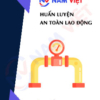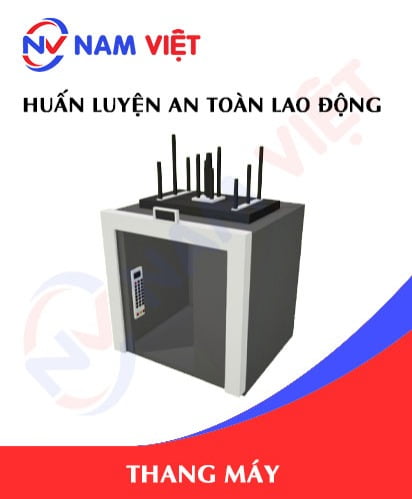Occupational Safety Training for Operating Electroencephalogram (EEG) Machines
99,000 ₫
Note: The above price is calculated per person and may vary depending on the number of trainees participating in the course and market fluctuations. For more accurate pricing support, please refer to the pricing list or contact our consulting staff directly.
Occupational safety is an important issue when operating the Electroencephalogram (EEG) machine and needs to be addressed promptly to ensure the health and safety of workers and enhance the reputation of businesses here. The Occupational Safety Training is one of the effective solutions to raise awareness on how to prevent occupational accidents for workers operating the Electroencephalogram (EEG) machine.
Table of Contents
Toggle1. Overview of Electroencephalogram (EEG) Device
a. What is an Electroencephalogram (EEG) Device?
The Electroencephalogram (EEG) device is a medical tool used to record the electrical activity of the brain. The operating principle of the EEG device is based on recording electrical signals from the activity of neurons in the brain. Electrodes are placed on the patient’s scalp to capture these electrical signals.
The EEG device is commonly used in various medical applications, including:
- Diagnosis of brain disorders: EEG is often used to diagnose disorders related to brain electrical activity, such as epilepsy, sleep disorders, and other brain-related conditions.
- Epilepsy treatment: EEG can be used to monitor the effectiveness of therapy for patients with different types of epilepsy. It can also guide medication dosage adjustments.
- Brain activity research: EEG provides important information about brain electrical activity while patients perform tasks such as problem-solving, memory recall, or experiencing different mental states.
- Sleep disorder evaluation: EEG can record changes in brain activity related to sleep, helping diagnose sleep disorders such as insomnia, REM sleep behavior disorder, and characteristic sleep disturbances.
- Intraoperative brain monitoring: In some cases, EEG is used to monitor brain electrical activity during surgery, especially brain surgeries.

b. Operating principle of the Electroencephalogram (EEG) device
The operating principle of the EEG device is based on recording and analyzing electronic signals generated by the brain’s electrical activity. The basic steps of EEG operation are as follows:
- Signal recording: The EEG device uses electrodes placed on the patient’s scalp to record electrical signals from brain activity. Electrodes are strategically positioned on the scalp to capture accurate signals from different brain regions.
- Amplification: The electrical signals recorded by the electrodes are usually very small, so they are amplified by amplifiers to produce stronger and more processable signals.
- Filtering: The recorded electrical signals are often disturbed by external noise sources like muscle movements, so filtering is applied to remove noise and keep only accurate brain signals. This is typically done using electronic filters in the EEG device.
- Recording: After amplification and filtering, the electrical signals are recorded and stored for analysis. Usually, the signals are recorded in time-graph form, showing the signal variations over time.
- Interpretation: The recorded data is analyzed by specialists to make conclusions about the patient’s brain activity. EEG analysis may include evaluating brain waves such as alpha, beta, theta, and delta waves, as well as detecting and assessing abnormal brain activity patterns.

c. Industries that use the Electroencephalogram (EEG) device
The EEG device is widely used in various fields, including:
- Medicine: In medicine, EEG is used to diagnose and treat disorders related to brain activity, including epilepsy, sleep disorders, Parkinson’s disease, Alzheimer’s, and many other conditions. It is also used to monitor brain activity during brain surgery.
- Scientific research: EEG is used in brain activity research such as mood studies, sleep research, problem-solving, and other aspects of human thought and mind.
- Clinical medicine: In medical facilities, specialists such as neurologists, pathologists, and nuclear medicine doctors commonly use EEG to diagnose and monitor brain-related disorders.
- Performance enhancement: Some organizations and companies use EEG as a tool to research and develop methods to improve performance, focus, and concentration in work environments.
- Education and training: EEG can also be used in some educational applications to study learning processes and intelligence.
- Home medical devices: Some portable EEG devices have been developed for home use to help monitor and manage disorders such as sleep disorders.

2. Overview of Occupational Safety Training for Operating the Electroencephalogram (EEG) Device
a. What is Occupational Safety Training?
- Occupational safety training for operating the Electroencephalogram (EEG) device consists of sessions that equip workers with awareness on how to prevent workplace accidents. Workers who directly operate the EEG device belong to group 3.
- The safety training course helps workers recognize and avoid hazards, reducing risks of workplace accidents during their work.
REGISTER FOR OCCUPATIONAL SAFETY TRAINING SERVICE
b. Training duration
Initial safety training duration
- Total training time is at least 24 hours, including examination time.
- 8 hours of theory on the system of policies and laws regarding occupational safety and hygiene
- 8 hours of theory on basic knowledge of occupational safety and hygiene
- 4 hours of theory on specialized training content
- 2 hours of practice on specialized training content
- 2 hours of theoretical examination at the end of the course
The safety training center will schedule sessions depending on the availability of workers. Usually, there are 6 training sessions held over 3 days, provided that the manufacturing enterprise arranges continuous study time.
Periodic safety training duration
- Before the occupational safety card expires, workers who want reissuance must attend a periodic occupational safety training course, with a periodic training duration at least 50% of the initial training duration.
Explanation: the total duration of periodic occupational safety training is at least 12 hours, including examination time. After completing the periodic training and passing the test, workers will be reissued or extended their occupational safety card.
c. Training course content
| No. | TRAINING CONTENT | TRAINING DURATION (HOURS) | |||
| Total | Including | ||||
| Theory | Practice | Examination | |||
| I | System of policies and laws on occupational safety and hygiene | 8 | 8 | 0 | 0 |
| 1 | Overview of legal normative documents system on occupational safety and hygiene. | 6 | 6 | ||
| 2 | System of standards and technical regulations on occupational safety and hygiene. | 1 | 1 | ||
| 3 | Specific regulations of state management agencies on occupational safety and hygiene when constructing, expanding, or renovating works, facilities for production, use, storage, and inspection of machines, equipment, materials, and substances with strict occupational safety and hygiene requirements. | 1 | 1 | ||
| II | Basic knowledge of occupational safety and hygiene | 8 | 8 | 0 | 0 |
| 1 | Basic knowledge of hazardous and harmful factors in the workplace. | 4 | 4 | ||
| 2 | Methods to improve working conditions. | 1 | 1 | ||
| 3 | Safety culture in production and business. | 1 | 1 | ||
| 4 | Rights and obligations of employers and employees; policies and regimes on occupational safety and hygiene for workers; functions and duties of the safety and hygiene network. | 1 | 1 | ||
| 5 | Occupational safety and hygiene rules, safety signs, instructions, use of safety equipment and personal protective equipment; accident first aid skills and occupational disease prevention. | 1 | 1 | ||
| III | Specialized training content | 6 | 4 | 2 | 0 |
| Comprehensive knowledge about machines, equipment, substances causing hazardous and harmful factors; analysis, assessment, and risk management of occupational safety and hygiene; safe working procedures with machines, equipment, and substances requiring strict occupational safety and hygiene. | 6 | 4 | 2 | ||
| IV | Safety training course final examination | 2 | 2 | 0 | 0 |
| Total | 24 | 22 | 2 | ||
See more training content for 6 groups
d. Occupational safety card
After completing the occupational safety training course and passing the exam, workers will be issued an occupational safety card (commonly called the occupational safety certificate for group 3).
The group 3 safety card clearly shows information such as: full name, date of birth, specific job and work environment. It also includes training duration, red stamp, and signature confirming completion of the training course.
According to the card issuance regulations stated in clause 2 of Article 24 of Decree 44/2016/ND-CP, there are two cases:
- If the employer and employee have a labor contract, the employer must sign, stamp, and endorse the safety card for the trained group 3 workers after they complete training from the occupational safety training unit and pass the exam.
- If the worker is freelance, seasonal, or does not have a labor contract, the training unit must sign, stamp, and endorse the safety card for the worker after completing training and passing the exam.

3. Hazards for Workers Operating the Electroencephalogram (EEG) Machine
When operating the Electroencephalogram (EEG) machine, workers may face several hazards and challenges as follows:
- Risk of pain and physical injury: Attaching and removing electrodes on the patient’s head may cause pain and injury if not done properly. Operators must ensure they are trained in safely placing and removing electrodes without causing discomfort or pain to the patient.
- Risk of external electromagnetic interference: EEG machines are sensitive to electromagnetic interference from external sources such as other electronic devices, bright lights, or other medical equipment. Minimizing this interference to ensure accurate signal recording is an important challenge when operating the machine.
- Electrical safety: Using electronic devices like EEG machines requires compliance with specific electrical safety measures to prevent accidents or electrical fires. This includes regular inspection and maintenance of electrical equipment and ensuring they are used in a safe environment.
- Patient data protection: EEG data often contains sensitive information about the patient’s brain activity, so operators must comply with data privacy regulations and ensure patient information is securely protected.
- Communication and patient handling: Working with patients during EEG procedures requires good communication skills to ensure they feel comfortable and cooperative. This may require the ability to work with patients who have mental conditions, children, or elderly individuals.

4. Accident Prevention Measures When Operating the Electroencephalogram (EEG) Machine
To control and reduce occupational accident risks when operating the EEG machine, several safety measures and procedures need to be implemented. Below are some occupational accident control measures for EEG operation:
- Training and certification: All personnel performing EEG-related procedures must be thoroughly trained in device operation, safety measures, and working procedures. They should also hold appropriate certifications to ensure they have the skills to work safely and effectively.
- Equipment inspection and maintenance: Ensure the EEG machine is regularly inspected and maintained to operate correctly and not pose danger to staff or patients. This includes checking electrodes, periodically setting filters and digital devices, and performing electrical safety checks.
- Patient instruction: Before EEG procedures, patients should be guided on the process and asked to comply with safety instructions, including how electrodes are attached and removed and conduct during the test.
- Use of protective equipment: EEG machine operators must use protective gear such as gloves, safety glasses, and reflective clothing to protect themselves from injury risks and electromagnetic interference.
- Electromagnetic interference control: Ensure the working environment is controlled to minimize electromagnetic interference from external sources like bright lights and other electronic devices.
- Emergency planning: Prepare emergency plans and train staff on handling urgent situations such as accidents or unexpected incidents during EEG operation.
- Periodic certification of the EEG machine to detect early safety issues such as damage, wear, or mechanical failures, thereby reducing the risk of occupational accidents.
5. Benefits of Occupational Safety Training
An Toàn Nam Việt offers your business the following great benefits after completing occupational safety training courses as regulated by Decree 44/2016/ND-CP on occupational safety and hygiene. Companies, factories, and enterprises will benefit as follows:
- Workers can recognize potential accident hazards and take preventive measures to avoid occupational accidents.
- Your business can establish risk prevention measures in production, operation, and maintenance processes.
- Reduce costs associated with occupational safety risks.
- Uninterrupted production processes help increase labor productivity and product quality.
- Comply fully with occupational safety laws to avoid legal risks.
- Create reputation and professionalism in all aspects, thereby elevating your business brand.
Nam Việt’s training courses are solutions to prevent and combat external factors affecting individuals so they can avoid dangers that may lead to injury or, worse, death.
REGISTER FOR OCCUPATIONAL SAFETY TRAINING SERVICES
6. Customer Feedback After Completing the Training Course
An Toàn Nam Việt has many years of experience accompanying numerous businesses in Vietnam in general and in southern provinces in particular. This responsibility is extremely precious to Nam Việt, which is why our Occupational Safety Training is increasingly professional. The motivation for An Toàn Nam Việt’s growth comes from both positive feedback and suggestions from businesses we serve. Below are some testimonials from our partners.
Bac Nam E&C Investment Construction Joint Stock Company
“My first experience with An Toàn Nam Việt surprised me due to the 24/7 enthusiastic support from the consulting team. Organizing the class was fast and convenient for our company. Thank you very much for Nam Việt’s service!”
Hoa Dat Construction and Trading Joint Stock Company
“Nam Việt’s service helped us greatly in simplifying occupational safety and completing safety documentation for our work process. The consulting team was enthusiastic and timely in responding to our questions. 5 stars for Nam Việt.”
See more customer interviews after using An Toàn Nam Việt’s services
7. An Toàn Nam Việt’s Occupational Safety Training Capability
An Toàn Nam Việt is a reputable and quality occupational safety training center in Vietnam today. Our safety training sessions are continuously held at manufacturing workshops, factories, and construction sites nationwide (63 provinces in Vietnam).
REGISTER FOR OCCUPATIONAL SAFETY TRAINING SERVICES
Occupational Safety Training License
- An Toàn Nam Việt has been inspected and granted a certificate of eligibility for occupational safety and hygiene training operation by the Department of Safety under the Ministry of Labor, Invalids and Social Affairs. This further strengthens our capacity for occupational safety training.

Training Materials and Lectures
- Before occupational safety training materials are included in ATLĐ courses, they are reviewed and approved to ensure lectures are accurate in knowledge and effective in application.
- Our instructors’ teaching methods are standardized according to An Toàn Nam Việt‘s teaching standards, which are methods developed and refined by experts in occupational safety and hygiene training to maximize learners’ knowledge absorption.
Facilities
- Controlling factors in the classroom environment that affect training enhances teaching efficiency and learners’ knowledge absorption.
- Our training facility always provides spacious classrooms that meet standards for area, lighting, training equipment, etc.
8. Nationwide Reputable and Quality Safety Training Center
At An Toàn Nam Việt, we prioritize the professional dedication to occupational safety training. For us, imparting knowledge about self-protection to workers so they are equipped with safety skills in their livelihood is a contribution to nation-building.
To ensure effective training, we meticulously prepare every detail, no matter how small—from preparing tools, teaching equipment to curricula, materials, sound, and lighting.
Our occupational safety trainers are experts with many years of experience in the field. They even have research projects identifying hazards across all industries and ways to prevent them.
The instructors’ lectures are practical and conveyed in the most vivid and easy-to-understand way for workers. These factors help learners feel comfortable during study and effectively absorb the knowledge we provide. Of course, the training content strictly follows Decree 44/2016/ND-CP.
From there, workers learn many hazard prevention measures and how to protect themselves. They also apply these appropriately in real work situations.
Our training center proudly provides reputable and professional occupational safety training services with the following advantages:
- Competitive training costs while maintaining quality.
- Flexible training schedules to fit company production demands.
- Quick and legally compliant certification issuance procedures.
- Experienced trainers with many years in the profession.
- Classrooms controlled for factors that enhance teaching efficiency and learner knowledge absorption.
- Training materials tailored to occupational safety at enterprises.
- An Toàn Nam Việt works with dedication and professionalism to support customers accurately and promptly.

9. Additional Occupational Safety Training Materials
- Occupational Safety Training Material Set
- Occupational Safety Materials for Operating the EEG Machine
- Occupational Safety Training Test Set
- Occupational Safety Multiple Choice Test for EEG Machine Operation
- EEG Machine Operation Occupational Safety Training Slide Deck
1 review for Occupational Safety Training for Operating Electroencephalogram (EEG) Machines
No comments yet















phanminhhang341
Đơn vị chuyên nghiệp về huấn luyện an toàn lao động